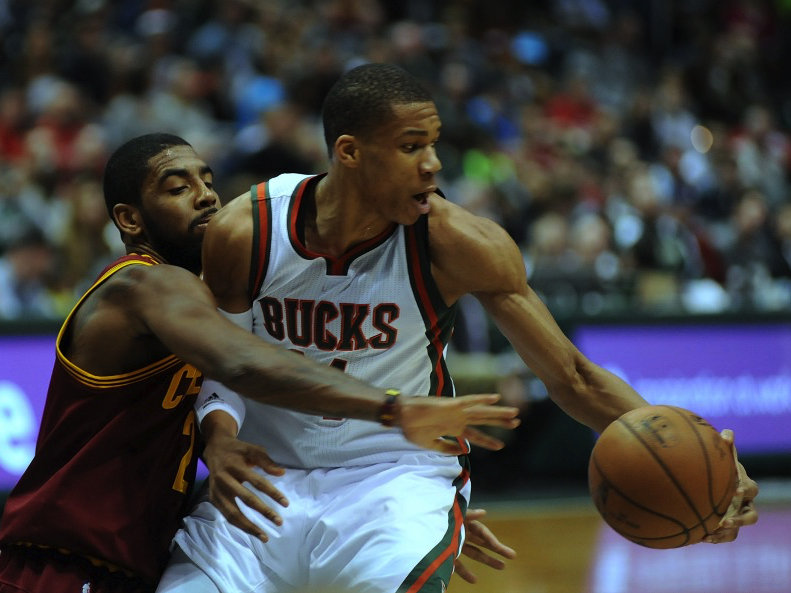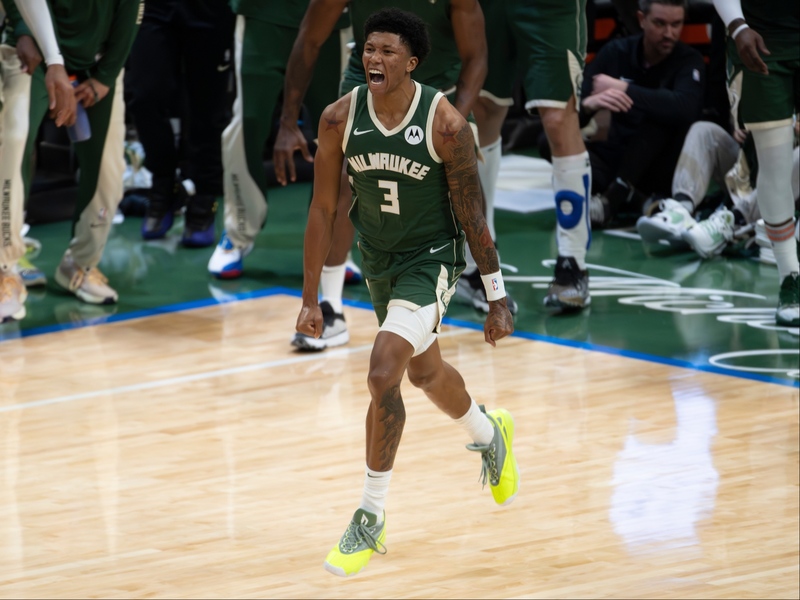There is a door just a few steps outside the film room at the Orthopaedic Hospital of Wisconsin Training Center – formerly the Cousins Center – which leads to a short staircase that winds down to the practice court.
It’s nothing special, unless you’re looking for quiet. For comfort.
It’s a place you could find a teenage Giannis Antetokounmpo after practices in his rookie year. There he would sit, a phone hidden in his capacious right hand, his left hand wrapped around his left ear, head bowed.
These are small stairs, and at 6-feet, 9-inches his knees rose to the top of his head as he sat curled like Rodin’s Thinker. Only, he was reaching for home, for family in Greece.
Once, he wandered up to that film room, and saw former Bucks assistant Nick Van Exel.
Coach, do you ever get lonely?
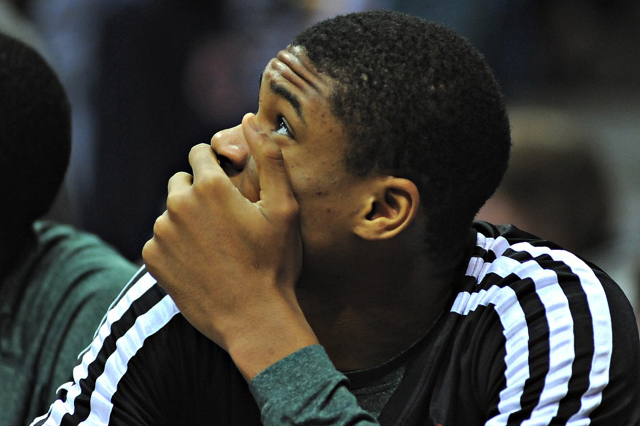
As his family struggled to get out of Greece, Antetokounmpo couldn't help but feel that way, even though he had two advantages in an easier acclimation.
One, was his personality.
Charming, funny, and always honest, he endeared himself to his older teammates. Like how he once wired all of his money home, requiring him to run to the BMO Harris Bradley Center. Or by learning to drive on a team employee’s Subaru Outback Legacy station wagon, and mastering parallel parking. By experiencing the wonders of his first snow and smoothies through his tweets and YouTube videos.
The second advantage was a Bucks roster that featured fellow international players Zaza Pachulia, Ersan Ilyasova, Miroslav Raduljica and Carlos Delfino.
"That makes it easier — I believe in that," Pachulia said of the bond between international players. "We want all the best for him. We are his teammates, we are his family members now, so we definitely want all the best for him. But again, everything starts with personality obviously. If he wasn’t a good guy it was going to be hard to play with him, work with him, be friends with him. But everything starts from there and obviously you build from that, the friendship."
But the miles they traveled to get to Milwaukee was the only line Antetokounmpo could draw from his teammates to himself. True, Pachulia and Ilyasova were also teenagers when they came to the United States, but they already had experienced some measure of fame in their home countries, were professionals, and had been coached by and played with grown men.
They also had family.
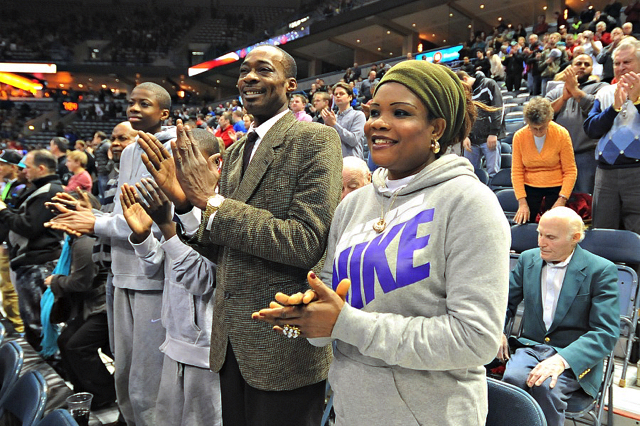
"He didn’t have anybody," Van Exel said one day as he watched Anteokounmpo begin yet another solitary post-practice workout.
"There are times when you just want to go over and just give him a hug and just ask him ‘are you okay?’ Not just about basketball, but are you okay? How are you doing mentally? Physically are you drained, are you tired? Things like that. Because he really has nobody to talk to."
Everyone, at some point, felt their young teammate's loneliness.
"It’s not about basketball," Ilyasova said of Antetokounmpo’s rookie campaign. "It’s about transition. Being in a different state, a different culture, experience a different culture. It’s all going to lay on you."
"I was worried, like maybe it was too much for him," Bucks general manager John Hammond admitted.
"But it wasn’t."
"Kobe was like 30 years old being 17," Van Exel told me then. "He was so mature. Giannis is just playful. Happy. Lots of energy and a pretty good basketball player."
As he said this, he was watching Antetokounmpo swing around on a rim after a practice, flexing his muscles.
But there was one element in this teenager that was the same in Bryant.
"He’s intense when he’s in a game situation, I’ll give him that," Van Exel said.
It just wasn't refined then. It's still not, actually.
It's nearly there, though, the 48 minutes of fury.
Make no mistake, Antetokounmpo has retained the "play" in his heart. The same kid who gushed over the Gucci shoes Larry Sanders purchased for him last year – who would only wear them in his house so as not to ruin them – still exists.
He'll still create situations like his first trip to Chipotle, when he attempted to order five individual burritos. The result was the ingredients for three chicken and two steak burritos jammed into a single monstrosity with multiple tortillas wrapped around one another to make it work.
He’ll tell you about his newfound love of pancakes. He’ll strut by the media and say he won’t talk while trying to stifle a grin.
He loves hearing his teammates mention his name in interviews – Did he say Giannis? Yes! Giannis! – and will crane his neck to see and hear what’s being said. He’ll attempt to sing so loudly in the shower that the sound fills the locker room, his vocal chords cracking at such a high pitch that once Pachulia instinctively winced, before rolling his eyes.
Such anecdotes will continue to pile up. It’s his nature.
But …
"He’s not sweet at all, trust me," Pachulia said. "When he comes to play, when the clock is on, I’ve seen his face. I love it. Off the court he doesn’t need to be as mean as on the court, to be tough and aggressive on the court is definitely a plus, definitely an advantage and definitely something to have in your game and your package.
"Off the court you leave all this madness."
Antetokounmpo can do that now that he no longer has to retreat to that stairwell, or an empty apartment.
On the court now, you can see what Van Exel saw glimpses of then.
Antetokounmpo wants to crush your windpipe. Then, he wants to tell you about it, and how he’s going to do it again.
If there was advantage to initial loneliness, to having nowhere to go for the formative parts of his NBA career, it was this: Antetokounmpo was able to hone his skill set and body to catch up to that nastiness; to lay the foundation of a work ethic that every teammate and coach alternately marvels at and wishes he could tone down.
A year ago, Van Exel would yell at his charge to get off the court, to go home. The end result was the coach waving his hand in exasperation as Antetokounmpo took more jump shots.
Thus far in year two, "He stays on the floor longer than probably we coaches would like," current Bucks head coach Jason Kidd admitted. "But that’s also a good thing because he likes to improve, he wants to get better."
And the now 20-year-old Antetokounmpo has improved.
He averaged just 6.8 points and 4.4 rebounds in his rookie year and currently sits around 13 points and seven rebounds in seven more minutes per game this season.
That noted, he is keenly aware of his own shortcomings. It’s why he watches film every day, logs his mistakes in writing. It's why he added the weight the team told him to last year, and the Bucks expect him to gain an additional 15 to 20 pounds by next season. The moments of him being knocked around inside quickly dwindling away.
That is what the coaching staff sees, what his teammates see, and to them, his improvement from year one to today qualifies as two, huge, Greek Freak-sized bounds down the court.
They see the understanding that he can’t make 3’s consistently – so he no longer takes them with as much regularity. But that's by design, and that part of his game is coming.
"I didn't shoot a lot of threes this year," he said. "Some people are going to say it's bad, some people are going to say it's good because he was more (aggressive). I say it's good. I've been working on my threes. I need to let it go. But I just didn't shoot it."
They see the wheels turning more quickly when left alone at 18 feet, to use the given space to begin a rush to the paint, using his stronger body and length to create position and a higher percentage attempt.
"I'm just try to be confident in the midrange (jumper) and I try to be more aggressive in the midrange jumper that I didn't have in the first year," he said. "The first year I made like five midrange jumpers. This year I'm making more."
He had two double-doubles as a rookie, and never could you say he dominated or made any real difference.
That is not the case now. He has recorded 10 double-doubles, has scored 17 or more points 17 times.
He’s affecting games.
"We could definitely see this coming," said Khris Middleton, one of several teammates who have seen his growth since day one.
"We knew if he kept working, kept learning, he’d be a great player. You’re starting to see that. He’s still working on his game. The improvement from last year to this year is crazy. Knowing that he can do more in the future, if he keeps learning and keeps working at his craft, I mean, the sky’s the limit for him."
Mayo, too, can only smile when talking about his young teammate.
The funny thing is, Mayo was once the phenom, the American teenager who trash talked Michael Jordan.
"He’s more so, one through 10, I would say a seven," Mayo said of Antetokounmpo’s spot on the developmental scale. "He’s still getting better. Every day you see the growth, man. Every day he’s learning. He’s wanting to get better. His biggest thing, his issue, is (what) you can’t rush, you can’t slow down, which is time."
Mayo shook his head.
"His thing is time, man. Honestly. I don’t know how to keep expressing that. It’s time, man. Next week, he’ll be a better player than he is today."
That continued improvement, of course, is what the Bucks organization is counting on.
Seventeen games of 17 points or more are nice, especially compared to last year, but he’s also scored fewer than 10 points 19 different times this season.
"I feel payoffs," he said. "I've been working hard all year. But I think next year, and then the year after, all gonna make sense. And the paths are are gonna to be together."
And, what happens when Jabari Parker is back and healthy?
In the 25 games the pair played together, Antetokounmpo averaged 12.2 points per game on 9.3 field goal and 4.2 free throw attempts in 27 minutes per game. His numbers are very similar (13.0 points, 9.8 field goal attempts, 4.2 free throw attempts) since Parker's injury, despite averaging nearly seven more minutes per game.
The Bucks can’t be sure if the steps he’s taken are because Parker isn’t there, or how he’ll react once Parker returns. After all, Antetokounmpo does take on-court chemistry seriously – he admitted becoming more passive with Michael Carter-Williams joining the starting five, needing games to adjust and reassert himself.
So, can he do it? Can he make the leap to a night-in, night-out box score stuffer, a Jermaine O’Neal-type, an All-Star who can average 17 points, 8 rebounds and 4 assists per game?
"He can be a difference maker. He is special," said Los Angeles Lakers coach Byron Scott, who played alongside Van Exel and a rookie Bryant in 1996.
"When you look at the skill level that he has, the way he can handle the ball, the way he can pass it, the things he can do offensively, he has a freakishness about him on the court that is undeniable. The guy is 20 years old. It seems like when he stretches his arms out he can touch baseline to baseline. He’s that long. If he continues to develop, they’ve got something special here."
If he … Can he? … Will he?
These are unknowns. They are the unanswerable questions. This is why playing for the future is always cloudy. But it’s what makes all of this so fun.
Because they see the natural talent, and the work; the progression from the lonely thinker in the stairwell to the player who has the confidence to not only read a defense, but call out one.
"It’s in you," Kidd said. "Sometimes it has to be brought out. But everybody has their own timetable of when it’s going to come out.
"You can see the growth. You can see the time. The more time he’s on the floor around some of the best players in the world, the better he’s going to be."
Time is something Antetokounmpo has plenty of. His family is now in Milwaukee, but he is still, often, the first to arrive and the last to exit.
"Next year, I'll be more efficient with that midrange jumper and try to work on the threes in the game, too," he said matter-of-factly. "And in the fourth year, try to bring all the pieces of the puzzle together."
To that end, his teammates no longer see a sad child. Nor do they see the hope of what could be. They see the reality that it takes to fulfill that hope, to be.
"This is a professional athlete’s life," Pachulia said. "There are important ages, like his age, and this is the time to get better. He should realize that and he should understand it, and I’m sure he does. It’s hard. It’s not easy. But that’s what it takes to become a great player, and I’m sure he wants to become a great player."
I spent some time talking about Antetokounmpo last year with Van Exel, who is now an assistant coach with the Dallas Mavericks’ NBA Developmental League team in Texas. While he always said the youthful, instant GIF of a player he was mentoring drove him crazy, he couldn’t help but think of the last teenager he was around on a daily basis: Kobe Bryant in 1996.
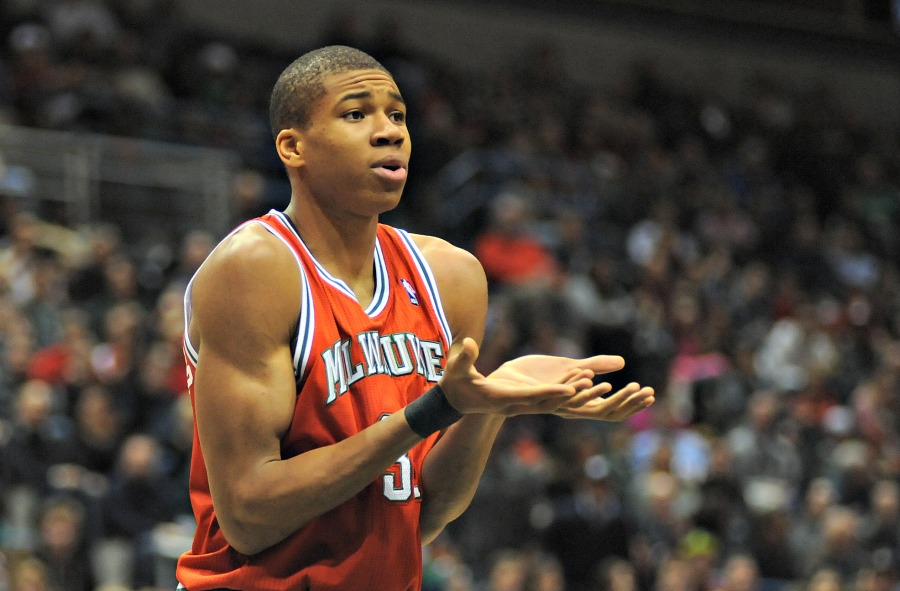
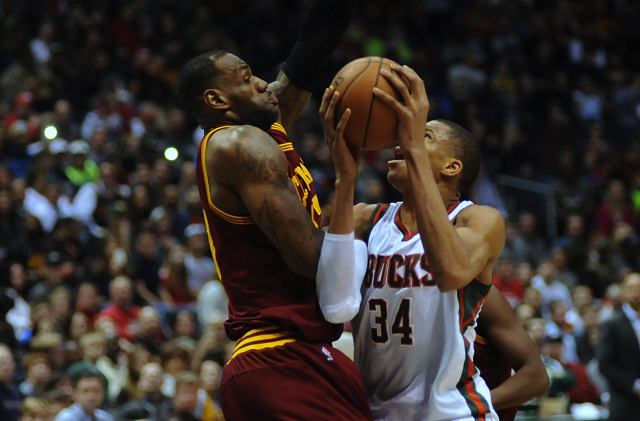
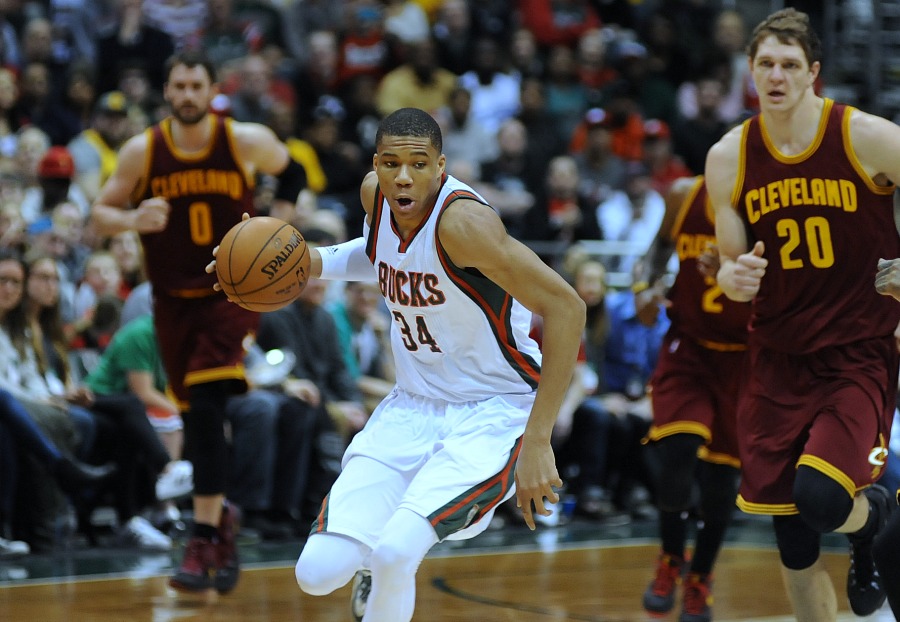
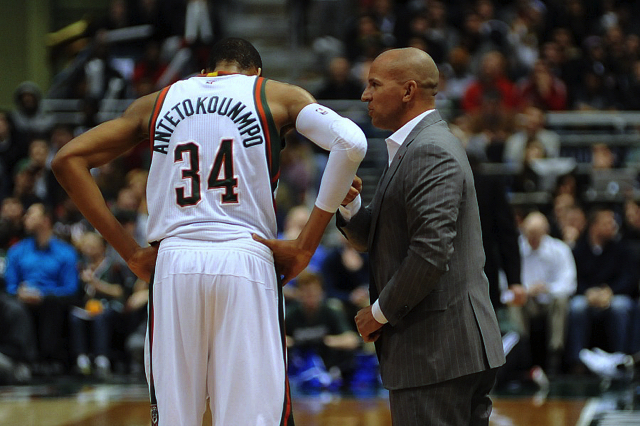
Jim Owczarski is an award-winning sports journalist and comes to Milwaukee by way of the Chicago Sun-Times Media Network.
A three-year Wisconsin resident who has considered Milwaukee a second home for the better part of seven years, he brings to the market experience covering nearly all major and college sports.
To this point in his career, he has been awarded six national Associated Press Sports Editors awards for investigative reporting, feature writing, breaking news and projects. He is also a four-time nominee for the prestigious Peter J. Lisagor Awards for Exemplary Journalism, presented by the Chicago Headline Club, and is a two-time winner for Best Sports Story. He has also won numerous other Illinois Press Association, Illinois Associated Press and Northern Illinois Newspaper Association awards.
Jim's career started in earnest as a North Central College (Naperville, Ill.) senior in 2002 when he received a Richter Fellowship to cover the Chicago White Sox in spring training. He was hired by the Naperville Sun in 2003 and moved on to the Aurora Beacon News in 2007 before joining OnMilwaukee.com.
In that time, he has covered the events, news and personalities that make up the PGA Tour, LPGA Tour, Major League Baseball, the National Football League, the National Hockey League, NCAA football, baseball and men's and women's basketball as well as boxing, mixed martial arts and various U.S. Olympic teams.
Golf aficionados who venture into Illinois have also read Jim in GOLF Chicago Magazine as well as the Chicago District Golfer and Illinois Golfer magazines.

